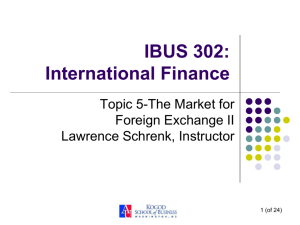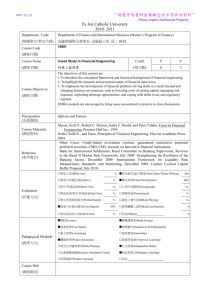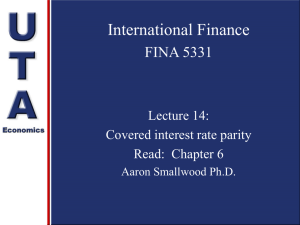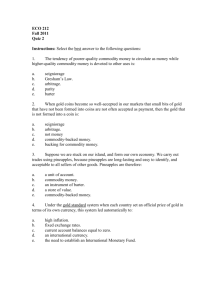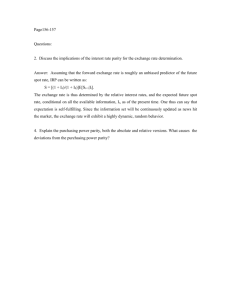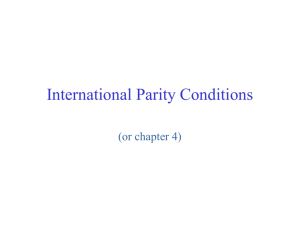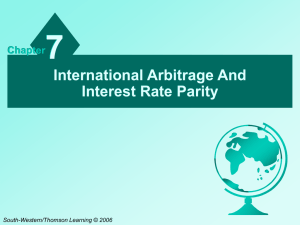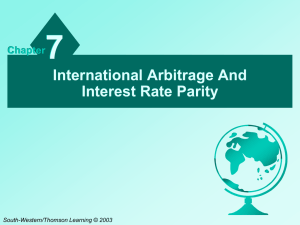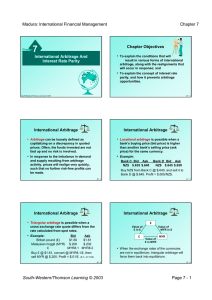Ch 7 Overheads
advertisement
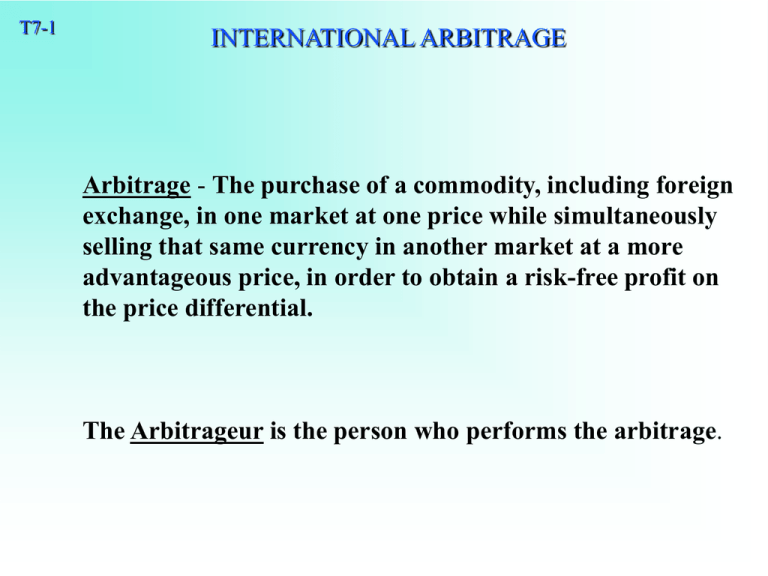
T7-1 INTERNATIONAL ARBITRAGE Arbitrage - The purchase of a commodity, including foreign exchange, in one market at one price while simultaneously selling that same currency in another market at a more advantageous price, in order to obtain a risk-free profit on the price differential. The Arbitrageur is the person who performs the arbitrage. T7-2 TYPES OF ARBITRAGE • Locational Arbitrage • Triangular Arbitrage • Covered Interest Arbitrage T7-3 LOCATIONAL ARBITRAGE Locational arbitrage involves taking advantage of differential pricing between locations. A B B .65 A .67 Buy at .67, sell at .68 Buy at .67, sell at .68 Buy at .67, sell at .68... B .68 A .69 T7-4 TRIANGULAR ARBITRAGE Triangular Arbitrage (aka “three-point” arbitrage) - involves taking advantage of unequal cross rates between two currencies, which is derived from their exchange rates with a third currency. T7-5 TRIANGULAR ARBITRAGE EXAMPLE London: New York: £/DM should be: Frankfurt: $/£ = $2.00 $/DM = $.40 .40/2.00 = .2 £/DM = .2 Assume that in London, $/£ is actually = $1.90 (out of line) • Start with $ and buy £1mil for $1.9mil in London • Buy DM at £/DM = .2 in Frankfurt (£1mil = DM5mil) • Use the DM5mil to buy $ in New York at $/DM = $.40 (DM5mil * .40 = $2mil) • Your profit would be $2mil - $1.9mil = $100,000 T7-6 COVERED INTEREST ARBITRAGE Covered Interest Arbitrage - involves buying or selling assets internationally (i.e., in more than one country), and using the forward market to eliminate exchange rate risk, in order to take advantage of return differentials between the two countries • Covered Interest Arbitrage will take place when... • the interest rate differential between two countries... • differs from the corresponding forward premium or discount on the exchange rate between their currencies T7-7 COVERED INTEREST ARBITRAGE EXAMPLE spot £ = $1.00 1-year forward = $1.10 (i.e., forward premium is 10%) U.S. interest rate = 25% British interest rate = 10% note: the difference in interest rates is 15%, which is > the forward premium • Borrow £1mil at 10% (£1.1mil due in 1 year) • Immediately convert the £ to $ and invest the $ at 25% (grows to $1.25mil) • Simultaneously enter into a forward contract that guarantees conversion of £ to $ at £/$ = $1.10 • At year end, deliver $1.25mil, and receive £1,136,364 ($1.25mil/$1.10) • Pay off the £1.1mil and keep the difference (£36,364 * $1.10 = $40,000 Profit) T7-8 INTEREST RATE PARITY (IRP) Interest Rate Parity - the theory states: The difference in the national interest rates for securities of similar risk and maturity should be equal to, but opposite in sign to, the forward rate discount or premium for the foreign currency, except for transaction costs. T7-9 IRP EQUATIONS (1) An = Ending amount of the home currency Ah = Beginning amount of the home currency Sj = The spot rate when the foreign currency was purchased ij = The foreign interest rate Fj = The forward rate on the foreign currency (1) An = (Ah/Sj)*(1+ij)Fj In words: End Amt Hm Cur = (Beg Amt Hm Cur/Beg Spot Rate) * (1+Foreign int rate)*(Forward Rate) T7-10 IRP EQUATIONS (2) • Since Fj = Sj(1+p), we can restate eq(1) as: An = (Ah/Sj)*(1+ij)*[Sj(1+p)] • Simplifying the above we have eq(2): (2) An = Ah(1+ij)*(1+p) • In words: End Amt of home currency = (Beg Amt home currency)*(1 + Foreign int rate) * (1 + forward premium or discount) T7-11 IRP EQUATIONS (3) The rate of return on an investment is: what you end up with, minus what you started with, divided by what you started with. rj = (An - Ah)/Ah Substituting for An in terms of Ah and then simplifying, we have eq(3), which is the return from covered interest arbitrage. (3) rj = (1+ij)*(1+p) - 1 In words: return = (1 + foreign int rate)*(1 + forward premium or discount) minus 1 T7-12 IRP EQUATIONS (4) • If Interest Rate Parity exists then... • The return from covered interest arbitrage... • should be equal to the rate of return available from investing domestically • In equation form we would say: • rj = i h • In words: • The return from covered interest arbitrage is equal to the return on a purely domestic investment of equal risk T7-13 • IRP EQUATIONS (5) rj = i h • but from eq(3) we know that rj = (1+ij)*(1+p) - 1 • therefore (1+ij)*(1+p) - 1 (1+ij)*(1+p) (1+p) = ih = (1+ih) = (1+ih)/(1+ij) T7-14 IRP EQUATIONS (6) (4) p = [(1+ih)/(1+ij)] - 1 (Covered Interest Parity) In words: The Forward premium or discount on the foreign currency is equal to (1 + domestic rate) divided by (1 + foreign rate) minus 1. T7-15 IRP NUMERICAL EXAMPLE (1) Spot Rate = 1.00 British Int. Rate = 7.5% U.S. Int. Rate = 5.2% • Because the British rates are higher than the U.S. rates... • The pound should be selling at a forward discount... • In order to equalize the returns between the U.S. and Great Britain • According to eq(4), that discount should be... [(1+.052)/(1+.075)] - 1 = -2.14% T7-16 IRP NUMERICAL EXAMPLE (2) • if the pound declines in value by 2.14% • then this will offset the additional British returns • and the returns to U.S. investors will be the same whether they invest in the U.S. or Great Britain • Assuming that the spot rate is 1.00... • Fj = Sj(1+p) = 1.00(1-.0214) = .9786 • 1.075 * .9786 = 1.052 T7-17 INTEREST RATE PARITY • in other words, even if you had invested at the higher British rate • by the time you converted your pounds back into dollars • your return would have been exactly the same as if you had simply invested in the U.S. in the first place T7-18 INTEREST RATE PARITY A simplified form of the IRP equation: (5) p = (Fj - Sj)/Sj ih - ij In words: The forward Premium or Discount (on the Foreign currency) is approximately equal to the difference between domestic and foreign interest rates. T7-19 INTEREST RATE PARITY Verifying... -.0214 = (.9786 - 1.00)/1.00 .052 - .075 .052 - .075 = - .0230 -.0214 T7-20 INTEREST RATE PARITY Foreign Rate > Domestic Rate Forward Currency Discount Foreign Rate < Domestic Rate Forward Currency Premium T7-21 INTEREST RATE PARITY ih - if (%) IRP Line Covered Arbitrage possible for foreign investors Forward Discount % Covered Arbitrage possible for domestic investors 45 ° Forward Premium % T7-22 TESTING IRP • Regress forward premium (or discount) on the interest rate differential • p = a0 + a1(ih - if) + e • Check to see if the slope coefficient, a1, is equal to 1.0 (which should be true if on 45 ° line. • or if the error term, e, is insignificant (which should also be true if IRP holds. T7-23 OTHER FACTORS IMPACTING IRP • Taxes • Transactions Costs • Additional Risks • Currency Restrictions • Etc.


